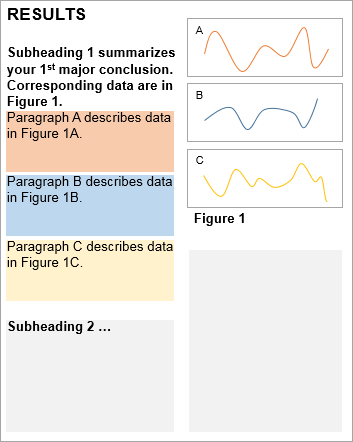Criteria for Success
- Data and conclusions drawn from them are described clearly and without speculation.
- Data are presented in a narrative flow with no logical leaps.
- The narrative builds to a take-home message.
Structure Diagram

Also, compare Authentic Annotated Examples for Methods and Results: note the correspondence of subheadings between the two sections.
Purpose
The goals of your Results section are:
- to describe and explain the data that you obtained with your methods, as objectively as possible and in a narrative form, and
- to communicate a take-home message based on those data.
While your figures give your readers the opportunity to directly examine your data and draw their own conclusions, the Results section offers more support for the process of interpreting data by explaining experimental logic, highlighting important data features, and stating your conclusions.
Speculation and extended interpretations belong in the Discussion, not in the Results.
Analyze Your Audience
The Results section of your paper is intended for readers who don’t feel confident analyzing your data and conclusions based on figures alone, or who prefer verbal information in addition to visual.
Certain types of readers may draw their conclusions directly from your figures, only occasionally referring to your results: readers who are in a hurry, or who are experts in your field, narrowly defined, and hence used to interpreting the same kinds of data as you (e.g., not just a biological engineer, but a systems biologist or a tissue engineer). However, many other readers rely on the Results to help them more thoroughly explore what you did and what you learned.
In particular, non-experts will benefit the most from your explanations in Results. Hence, don’t assume that readers know what the purpose of a given method is, or assume that the meaning of a given observation is self-evident: state your motivations and interpretations as explicitly as possible. Also, avoid field-specific jargon if a simpler term can be used instead.
You might ask a friend from a different lab to read your Results and help you identify unexplained jargon or places where rationale needs to be stated more clearly.
Skills
Create a logical narrative, organized into subsections
An excellent way to find a narrative order for your Results is to first organize your figures. Before writing your Results, you should have decided on the set of figures that will be included in your paper. Each Figure should support a specific conclusion, and provide the data that the reader needs to evaluate that conclusion (see Figures). Rearrange your figures until you’ve found an order that creates the most logical possible series of conclusions, leading to your final take-home. Use this series of figures/conclusions as the outline for your Results.
Each major conclusion (which may correspond to one or multiple figures) can become the title for a subsection of your Results. This modular organization will help readers navigate your paper by quickly matching figures to Results and vice versa. (See also “Use subheadings to organize content” in Methods.)
Each Results paragraph has rationale, data, and a transition
A single Results paragraph typically corresponds to a single experiment (or a group of closely related experiments), and a single figure or subpanel within a larger figure. (See Structure Diagram above.)
- Begin each Results paragraph with a topic sentence that explains the rationale for performing the experiment. For example, you may use a structure like this:
“In order to determine X, Y was performed, showing Z major results.”
- After the topic sentence, describe your data and the conclusions that you learned from it in a logical order: e.g., pro then con, most to least important, experimental versus control group.
- Conclude with a transition sentence that sums up findings, and, if necessary, justifies why you moved to the next experiment or hypothesis.
The only time that speculation can be included in Results is when it is necessary to explain a transition between experiments:
“Having observed data A, we speculated that mechanism B might cause phenomenon Z. Hence, the next experiment tested the activity of mechanism B by…”
Show minimal essential data
Describe all data necessary for your readers to evaluate your conclusions and no more than that; forcing your reader to parse through unnecessary details will distract them from your main message. Do not include data that are irrelevant to the given conclusion. Deciding which data are relevant can be tricky and often involves some judgment calls. It also depends on journal article length restrictions—the shorter your article, the more content you might have to move to Supplementary Information, or leave out.
Here are some general guidelines to help you decide which data to include and exclude:
| Include | Put in Supplementary Information, or exclude |
The experiment or dataset that is the strongest proof of your conclusion.
|
|
The amount of time you spend describing an individual result should be proportional to the importance of that result to the paper’s main conclusion. It’s tempting to write more when describing a result that’s complicated or confusing, but you don’t want to fill your reader’s head with details if they distract from the main conclusion. As you write, keep reminding yourself what the most important conclusions are, and allocate the most space and detail for their supporting details.
Use appropriate style
Results should be written in past tense.
Be as objective as possible. In addition to avoiding speculation, avoid phrases like “interestingly, we found that…”, unless that interestingness can be concretely justified—e.g., the result contradicts a major hypothesis, or past findings in the field.
